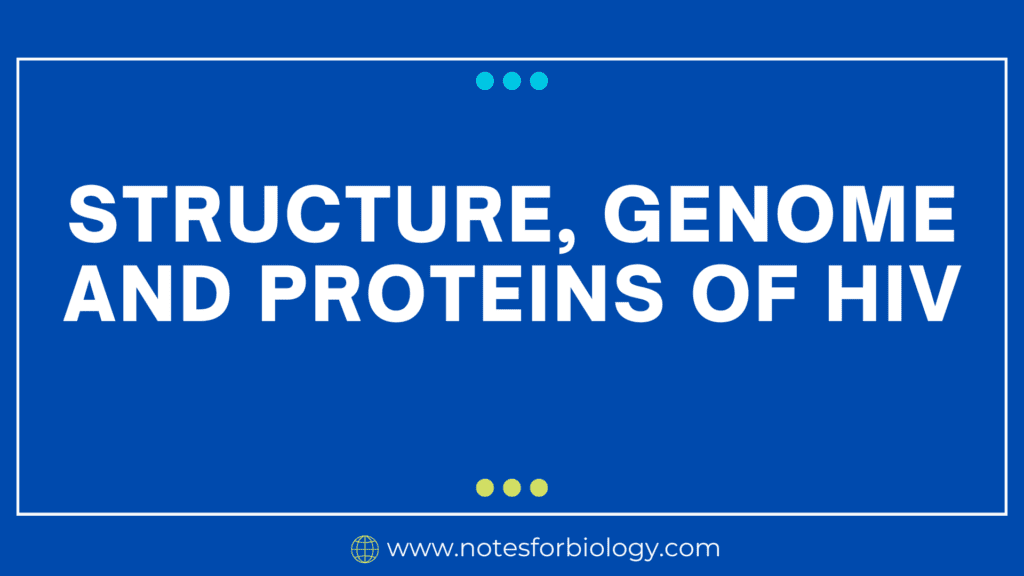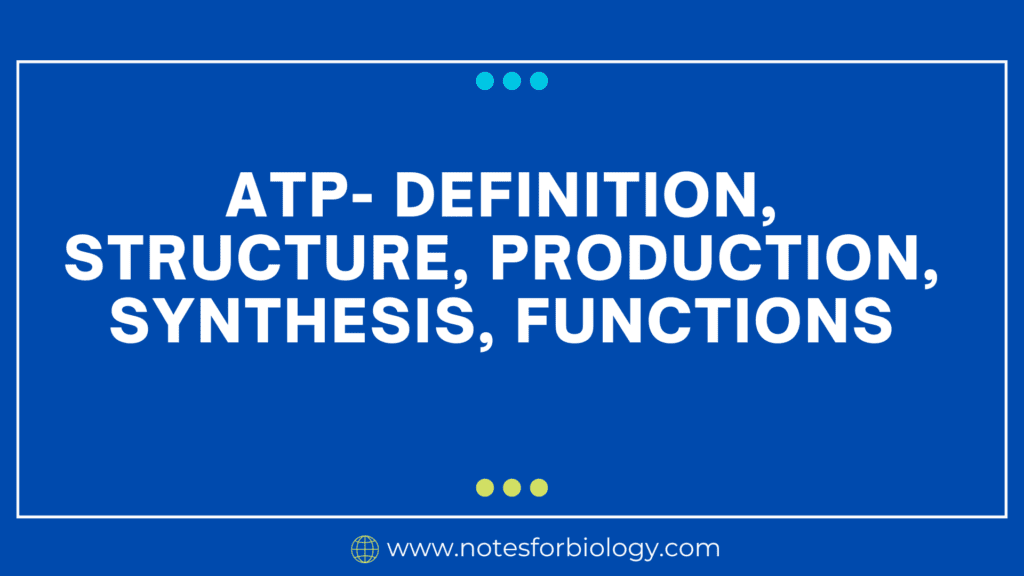Food chains reflect the easy transfer of energy and nutrients from one organism to another. They provide a clear and straightforward representation of how energy flows through an ecosystem. In a food chain, each organism belongs to a specific trophic level, beginning with producers that generate energy through photosynthesis and ending with top predators that have no natural adversaries. Decomposers perform an important function in breaking down dead organic matter and recycling nutrients back into the environment.
Table of Contents
Food chain
A food chain is a linear sequence of creatures that transfer nutrients and energy as one eats another. It depicts the transfer of energy from one trophic level to the next in an ecosystem. Food chains reflect the easy transfer of energy and nutrients from one organism to another. They provide a clear and straightforward representation of how energy flows through an ecosystem.
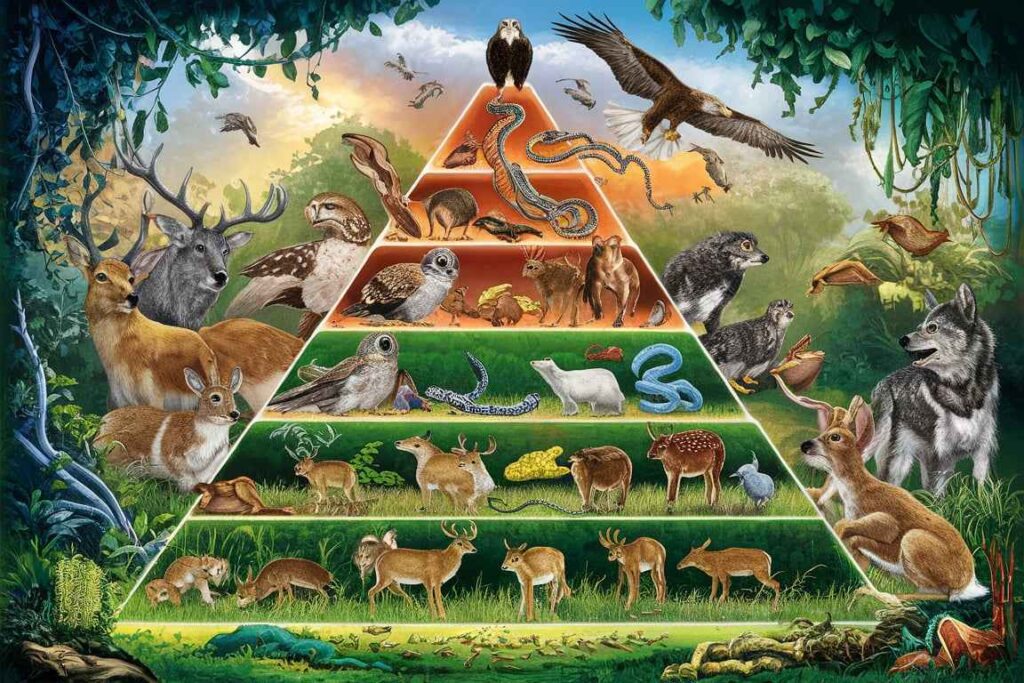
Structure:
Producers (autotrophs) are plants or algae that use photosynthesis to manufacture their own nourishment.
Primary consumers (herbivores) eat producers. Examples include insects, bunnies, and deer.
Secondary consumers (carnivores) devour prime consumers. Examples include frogs, tiny fish, and birds.
Tertiary consumers (top carnivores) eat secondary consumers. Lions, eagles, and sharks are good examples of huge predators.
Decomposers (Detritivores): These organisms degrade dead organic debris and restore nutrients to the soil. Examples include fungi, bacteria, and earthworms.
Example: Grass (Producer), Grasshopper (Primary Consumer), Frog (Secondary Consumer), and Snake (Tertiary Consumer).
A food web is an intricate network of interrelated food chains in an ecosystem. It illustrates the various paths through which energy and nutrients move between organisms.
Structure:
- Interconnected Food Chains: Unlike a food chain, a food web depicts how diverse food chains within an ecosystem are linked.
- Numerous Consumers: Organisms can have numerous predators and prey, resulting in a more accurate picture of ecosystem dynamics.
- Energy Flow: The food web depicts the flow of energy and nutrients across trophic levels, emphasizing species interdependence.
For example, consider a pond ecology
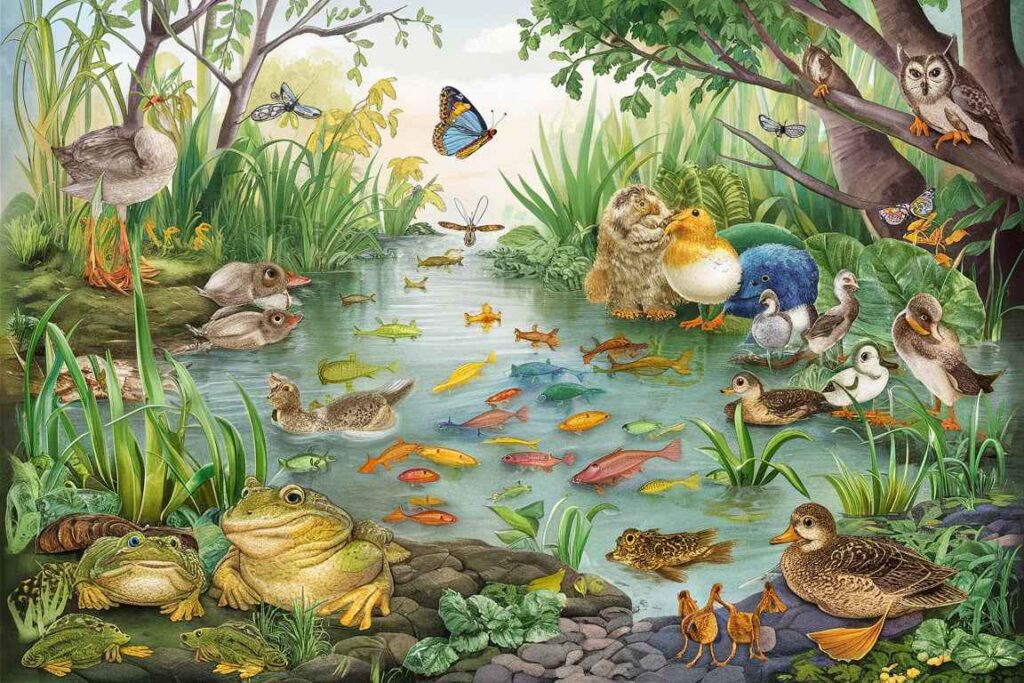
Algae lead to small fish, then large fish, then birds.
Algae → Zooplankton → Birds Plants → Insects → Small Fish → Birds
Ecological Pyramids
Ecological pyramids are graphical representations of the relationships between trophic levels in an ecosystem. There are three main types: numerical pyramids, biomass, and energy.
Types:
1. Pyramid of numbers:
Definition: Displays the number of individual organisms at each trophic level.
For example, in a grassland ecosystem, the pyramid may display a vast number of grasses but few herbivores and even fewer carnivores..
2. Pyramid of biomass:
Definition: Displays the total mass of living matter at each trophic level.
For example, in a forest environment, the biomass pyramid may show a huge mass of trees, a smaller amount of herbivores, and a smaller mass of carnivores.
3. Pyramid of Energy:
Definition: Shows the amount of energy available at each trophic level, usually measured in kilocalories.
For example, in an aquatic ecosystem, the energy pyramid may show a high concentration of energy in phytoplankton, low concentrations in zooplankton, and even lower concentrations in fish and top predators.
Characteristics:
- Shape: Pyramids of energy are always upright, however pyramids of numbers and biomass can be inverted depending on the ecology.
- Energy Loss: Energy Pyramids show the loss of energy at each trophic level as a result of metabolic activities and heat loss.
- Prompt: Food Chain, Food Web, and Ecological Pyramids
Objective:
Understand the significance of food chains, food webs, and ecological pyramids in ecosystems.
Materials needed:
Examples and diagrams of food chains, food webs, and ecological pyramids.
Information about several ecosystems to provide context and examples.
Visual aids, such as charts or posters, are used to illustrate concepts.
Procedure:
Create a simple food chain diagram for a certain environment, such as grassland, forest, or aquatic.
Identify and label the producers, primary and secondary consumers, tertiary consumers, and decomposers.
Create a food web for a single environment by discovering connecting food pathways.
Highlight the various trophic interactions to demonstrate the complexity of the ecosystem.
Ecological pyramids:
Make pyramids of numbers, biomass, and energy for your chosen environment.
Discuss each pyramid’s shape and structure, as well as its energy flow and biomass distribution.
Interpretation of results:
Food Chain
Food Chain: Determine the linear flow of energy and nutrients from one trophic level to the next.
Food Web: Learn about the relationships between creatures and the complexities of trophic interactions.
Ecological Pyramids: Examine the distribution of population, biomass, and energy at various trophic levels, and consider the implications for ecosystem dynamics.
Food chains transfer energy and nutrients from one organism to another. They provide a clear and straightforward representation of how energy flows through an ecosystem. In a food chain, each organism belongs to a specific trophic level, beginning with producers that generate energy through photosynthesis and ending with top predators that have no natural adversaries. Decomposers perform an important function in breaking down dead organic matter and recycling nutrients back into the environment.
Food webs
Food webs accurately replicate real-world ecosystems with various feeding interactions. This intricacy maintains ecosystem stability, as the extinction of one species might have far-reaching consequences for others. Food webs show how energy moves through various trophic levels and highlight species interdependence within an ecosystem. They also provide redundancy in food supplies for consumers, which helps to mitigate the loss of any particular species.
Ecological pyramids
Ecological pyramids illustrate the energy, biomass, and number of species at different trophic levels. Pyramids of energy are always upright, representing the loss of energy at each trophic level caused by metabolic processes and heat. In some ecosystems, such as aquatic habitats, biomass pyramids can be inverted, with phytoplankton (producers) having less biomass than herbivores that consume them. Ecologists can use these pyramids to better understand the efficiency of energy transfer and biomass distribution throughout ecosystems.
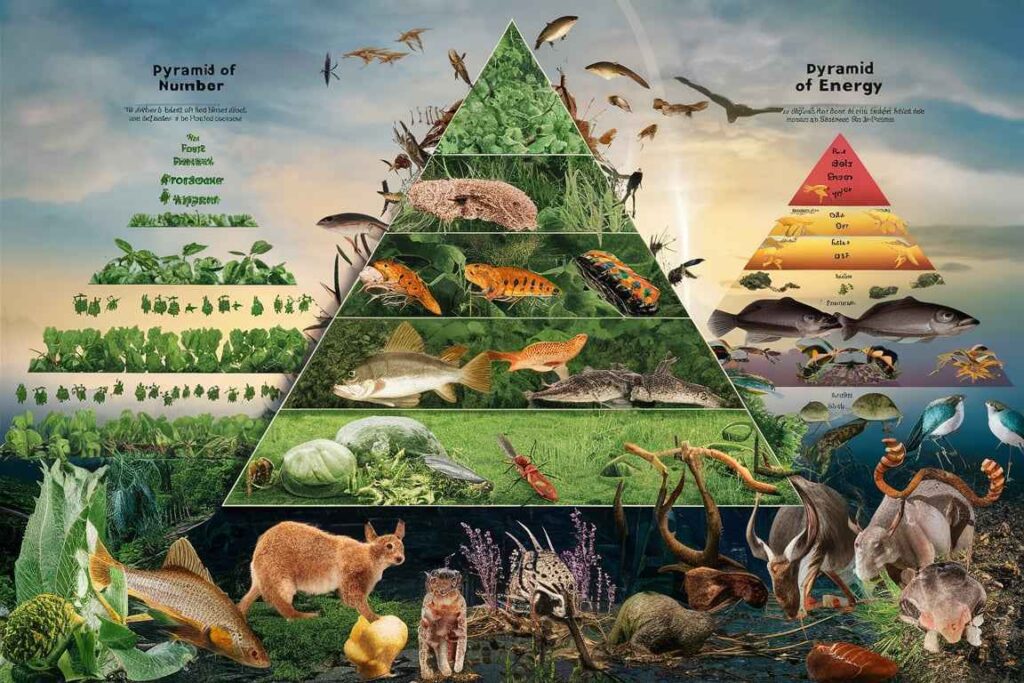
Ecologists learn about the structure and function of ecosystems, the flow of energy and nutrients, and the interactions between diverse organisms by studying food chains, food webs, and ecological pyramids. This understanding is critical for conservation efforts, ecosystem management, and forecasting the effects of environmental change on biodiversity and ecosystem health.
Frequently Asked Question
What is Food chain?
A food chain is a linear sequence of creatures that transfer nutrients and energy as one eats another. It depicts the transfer of energy from one trophic level to the next in an ecosystem.
What is Food webs ?
Food webs accurately replicate real-world ecosystems with various feeding interactions. This intricacy maintains ecosystem stability, as the extinction of one species might have far-reaching consequences for others.
What is Ecological pyramids ?
Ecological pyramids are graphical representations of the relationships between trophic levels in an ecosystem. There are three main types: numerical pyramids, biomass, and energy.
Related Article


